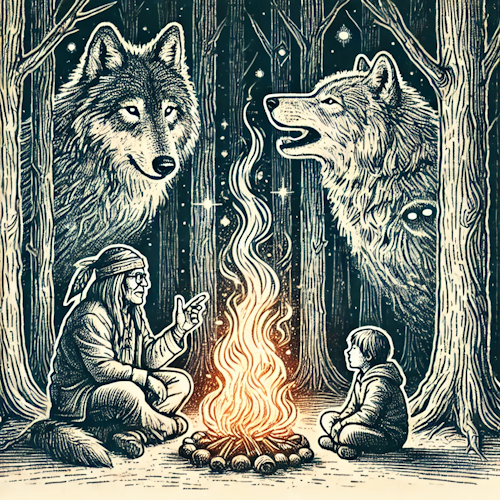The Tale of The Two Wolves
Illustrates Inner Conflict, Mindset, Leadership Intent
Agile organizations thrive not just on frameworks, but on mindset. And mindset is shaped by what we feed: our beliefs, behaviors, and reactions to challenge. One of the most enduring parables that speaks to this is The Tale of the Two Wolves.
Agile transformation is not just external. It is internal. This story reminds us that what we nurture within ourselves and our teams becomes the culture we embody.

An old Cherokee is teaching his grandson about life.
"A fight is going on inside me," he said to the boy. "It is a terrible fight and it is between two wolves. One is evil. He is anger, envy, sorrow, regret, greed, arrogance, self-pity, guilt, resentment, inferiority, lies, false pride, superiority, and ego."
"The other is good. He is joy, peace, love, hope, serenity, humility, kindness, empathy, generosity, truth, compassion, and faith."
"The same fight is going on inside you, and inside every other person, too."
The grandson thought about it for a minute and then asked his grandfather, "Which wolf will win?"
The old Cherokee simply replied, "The one you feed."
Lessons Learned
Culture Grows From What Gets Reinforced
The behaviors we celebrate, tolerate, or ignore determine which wolf grows. In Agile teams, feedback loops, rituals, and leadership behavior either reinforce collaboration or cultivate fear.
Agile Mindset Is a Daily Practice
Agility is not a status. It's a mindset you choose and practice. Like feeding the good wolf, it involves consistent focus on transparency, collaboration, and improvement, even when it's hard.
Internal Conflict Affects Team Dynamics
Just as individuals struggle with competing internal drives, so do teams. Competing priorities, values, and egos show up in meetings, decisions, and deliverables. Awareness and conversation help teams choose which wolf to feed together.
Leadership Is an Act of Attention
Leaders and coaches set the tone. If you feed anxiety, blame, and urgency, those behaviors will grow. If you feed curiosity, care, and learning, teams grow resilient. Energy flows where attention goes.
You Can't Eliminate the Bad Wolf, but You Can Starve It
There is no perfect team or person. The bad wolf will always be there. The power lies in noticing when he gets fed, and choosing differently next time. Reflection turns mistakes into insight.
Coaching Tips
- Make It Personal: Invite team members in retrospectives or 1:1s to reflect on what behaviors they've been feeding lately. Are they operating out of fear or intention?
- Spot the Wolves in Team Norms: Are team agreements nurturing the right dynamics? Is your Definition of Done feeding quality and empathy, or speed and rework?
- Track Technical Debt and Friction: Ask teams, “What slows you down?” and prioritize improvements.
- Use as Metaphor in Conflict: When tension rises, ask: "Which wolf are we feeding right now?" This creates space to reframe the conversation.
- Coach Leaders to Model the Good Wolf: The good wolf shows up through humility, vulnerability, and service. Leaders do not need to be perfect. They need to be aware.
The Tale of the Two Wolves is not just a story about individual character. It is a mirror for how cultures are created, how mindsets are shaped, and how teams decide who they want to become.
In every moment, every conversation, every Sprint, we are feeding one wolf or the other. Agile coaches help teams make that choice with clarity.
Feed the good wolf.


